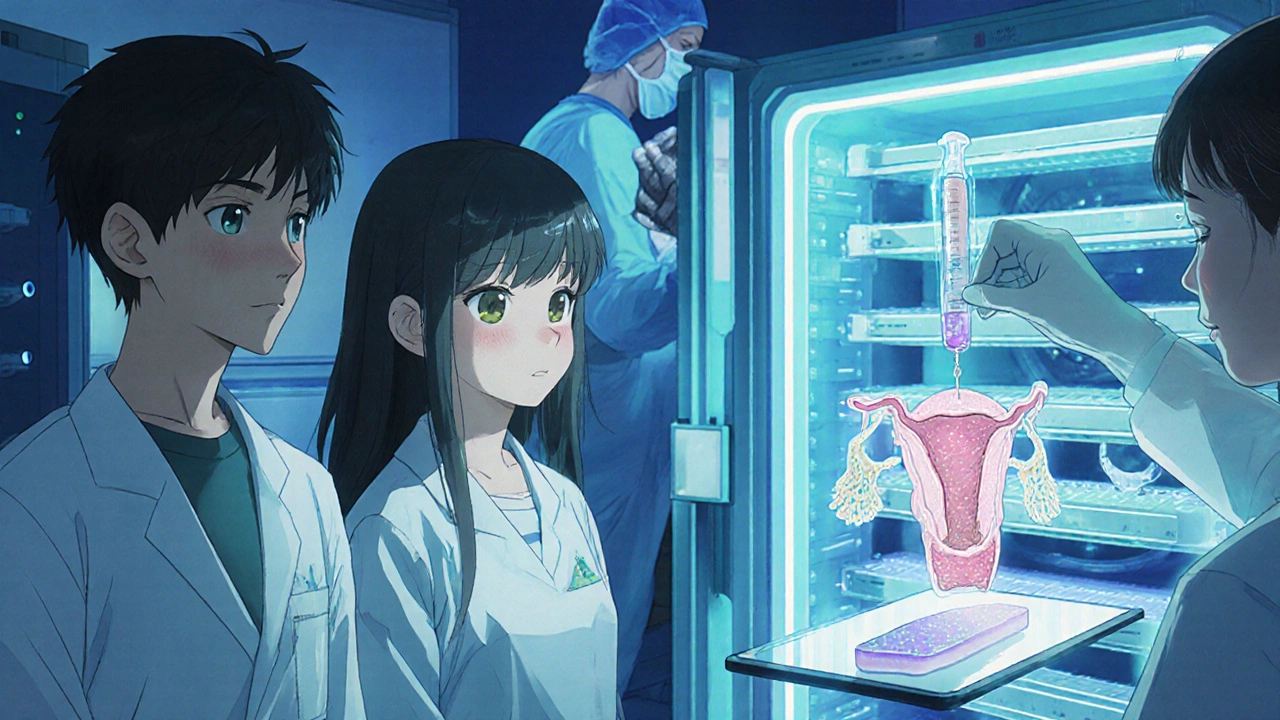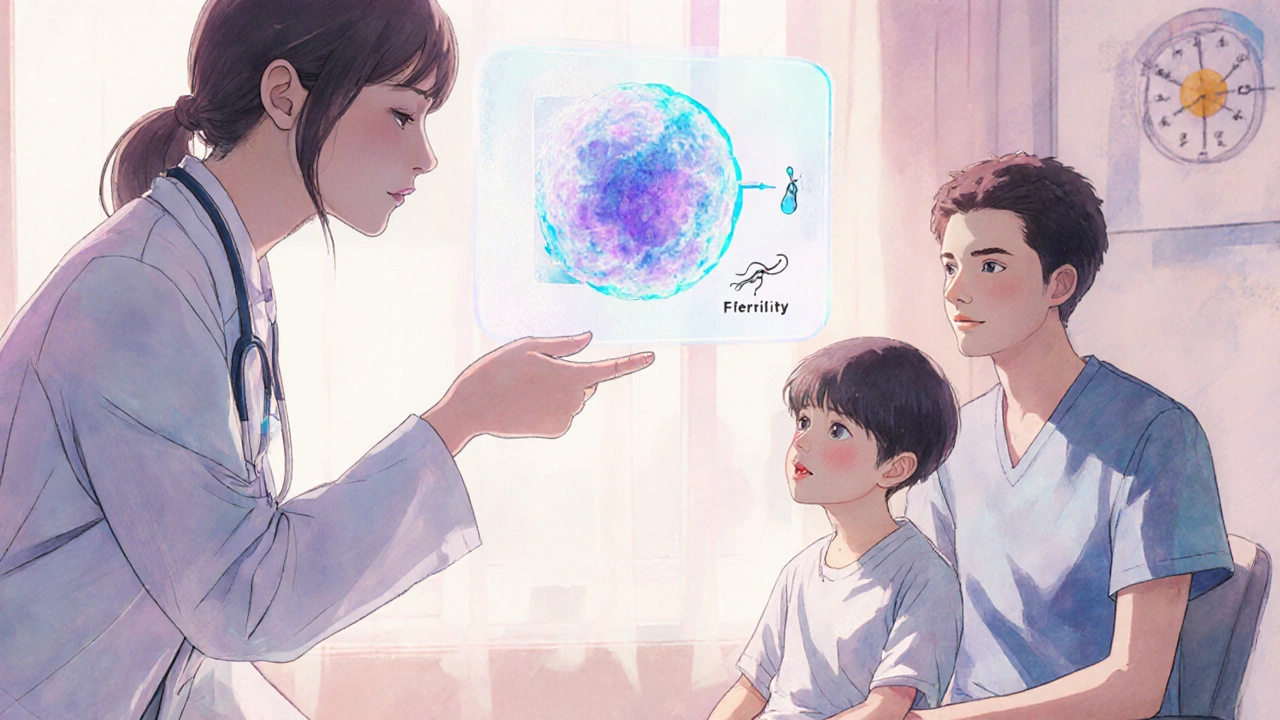Neuroblastoma Fertility Risk Calculator
Treatment Risk Assessment
Enter your treatment details to determine fertility risk level and appropriate preservation options.
Your Fertility Risk Assessment
Risk Level:
Next Steps:
Facing a neuroblastoma diagnosis is overwhelming, but many families later wonder about a question that isn’t often on the first‑line discussion: how will treatment impact future fertility? This guide walks you through the biology, the risks, the options to protect reproductive health, and what survivorship looks like after treatment.
What Is Neuroblastoma?
Neuroblastoma is a childhood cancer that originates in nerve tissue, most commonly in the adrenal glands or along the spine. It accounts for about 7% of all pediatric cancers and is the most common solid tumor in infants. Because it develops early, treatment plans often involve aggressive multimodal therapy, which can include surgery, chemotherapy, radiation, and sometimes stem‑cell transplant.
Why Fertility Matters for Survivors
Survivors of neuroblastoma are living longer, and many reach adulthood with goals that include starting a family. Understanding how cancer therapy can affect the reproductive system helps patients and caregivers make informed choices early, reducing the risk of unexpected infertility later on.
How Treatment Impacts Fertility
Several treatment modalities are known to be neuroblastoma fertility concerns:
- Chemotherapy: Alkylating agents such as cyclophosphamide, ifosfamide, and melphalan are highly gonadotoxic. They damage sperm‑producing cells in testes and egg‑producing follicles in ovaries.
- Radiation Therapy: Direct radiation to the abdomen, pelvis, or spine can impair gonadal function. Even scattered doses to the ovaries or testes can reduce hormone production.
- Surgery: Removal of tumors near reproductive organs can sometimes involve removal of part of the gonads or disrupt blood supply.
- Stem Cell Transplant: High‑dose chemotherapy used before transplant raises the gonadotoxic load dramatically.
Factors that modify risk include the child’s age at treatment, total cumulative dose, and whether both gonads are exposed. Younger patients generally have a higher chance of ovarian recovery because they start with a larger follicle pool, whereas pre‑pubertal boys have limited data on spermatogenic recovery.

Assessing Individual Fertility Risk
Oncologists use the term Gonadotoxicity to classify how likely a regimen is to cause lasting infertility. The Children's Oncology Group (COG) provides risk categories:
- Low risk - minimal or no exposure to alkylating agents and no pelvic radiation.
- Intermediate risk - moderate doses of alkylators or limited pelvic radiation.
- High risk - high‑dose alkylators, total body irradiation, or stem‑cell transplant.
Baseline hormone testing (FSH, LH, estradiol, testosterone) and, when age‑appropriate, semen analysis or ovarian ultrasound can help establish a fertility baseline before treatment starts.
Fertility Preservation Options Before Starting Therapy
When the treatment plan falls into an intermediate or high‑risk category, oncofertility specialists recommend exploring preservation methods. Options differ by gender and age:
| Method | Suitable For | Procedure Summary | Success Rate (live birth) | Key Considerations |
|---|---|---|---|---|
| Sperm Banking | Post‑pubertal males | Multiple semen samples are frozen after ejaculation. | 30‑60 % | Requires masturbation; storage costs apply. |
| Egg Freezing (Vitrification) | Post‑pubertal females | Hormonal stimulation then retrieval of mature eggs for freezing. | 35‑45 % | Delay of 2-3 weeks before cancer therapy; hormone exposure. |
| Ovarian Tissue Cryopreservation | Pre‑pubertal and post‑pubertal females | Small slice of ovarian cortex removed laparoscopically and frozen. | ~20 % (still experimental) | Can be done quickly; later transplantation may restore function. |
| Testicular Tissue Cryopreservation | Pre‑pubertal males | Testicular biopsy is frozen; future fertility restoration is experimental. | Experimental | Only option for boys who haven’t produced sperm yet. |
| Embryo Freezing | Couples where female partner is post‑pubertal | In‑vitro fertilization creates embryos that are frozen. | 40‑55 % | Requires partner or donor sperm; ethical considerations. |
Choosing a method depends on family preferences, the child’s developmental stage, and the timing of cancer therapy. Many pediatric centers now have dedicated oncofertility coordinators to streamline referrals.
Managing Fertility After Treatment
Once therapy is complete, the focus shifts to monitoring recovery and planning for family building later on. Here’s what typically happens:
- Hormone Monitoring: Regular blood tests track gonadal hormone levels. Low estrogen or testosterone may indicate the need for hormone replacement.
- Timed Reproductive Assessments: For females, antral follicle counts via transvaginal ultrasound help gauge ovarian reserve. For males, semen analysis at 12‑18 months post‑therapy gives insight on spermatogenic recovery.
- Assisted Reproductive Technologies (ART): If natural conception is difficult, options like intrauterine insemination (IUI) or in‑vitro fertilization (IVF) can be pursued using frozen gametes or donor material.
- Psychological Support: Fertility concerns are emotionally charged. Connecting with survivorship support groups can reduce anxiety and improve decision‑making.
Importantly, many survivors regain partial or full fertility, especially those who were pre‑pubertal at the time of treatment and received lower‑dose regimens.

Long‑Term Follow‑up and Survivorship Care
Survivorship clinics integrate fertility into broader health monitoring. The Survivorship Care Plan typically includes:
- Annual endocrine evaluation.
- Screening for secondary cancers.
- Bone health assessment (some hormonal therapies affect bone density).
- Reproductive counseling at milestones - high school graduation, college, or when the survivor expresses interest in starting a family.
Patients are encouraged to keep a personal health record, noting dates of treatment, doses of chemotherapy, and any preservation procedures performed. This information is vital when consulting reproductive specialists later.
Practical Tips for Families
- Ask the oncology team early about Oncofertility resources - many hospitals have a dedicated nurse or social worker.
- Document all medication names, doses, and radiation fields; this helps risk stratification.
- Consider insurance coverage for preservation; many policies now reimburse sperm banking and egg freezing.
- Maintain a healthy lifestyle during and after treatment - nutrition, moderate exercise, and avoiding smoking support hormonal recovery.
- Stay connected with patient advocacy groups like the St. Baldrick’s Cancer Foundation, which offers fertility grant programs.
Frequently Asked Questions
Can a child who has never produced sperm still have biological children later?
Yes. Testicular tissue cryopreservation is experimental but shows promise. Researchers have successfully generated sperm from frozen tissue in animal models, and early human trials are underway. If the technique matures, the child could have his own genetic material for IVF.
Is hormone replacement therapy (HRT) necessary after high‑dose chemotherapy?
Not always. HRT is considered when hormone levels remain low for more than 12 months post‑treatment and symptoms of menopause or hypogonadism appear. A pediatric endocrinologist can guide timing and dosing to support growth and bone health.
How long can frozen gametes be stored safely?
Current data show successful pregnancies from sperm and eggs stored for over 20 years. As long as the storage facility follows proper cryogenic protocols, there is no defined expiration.
What signs indicate that my teen may be facing infertility?
For females, irregular menstrual cycles, absent periods, or consistently low AMH (anti‑Müllerian hormone) levels suggest reduced ovarian reserve. For males, a low semen count or difficulty producing a sample can be early flags. Any concerns should prompt a referral to a reproductive endocrinologist.
Are there any lifestyle changes that improve fertility after cancer?
Yes. Maintaining a healthy weight, regular moderate exercise, limiting alcohol, and avoiding smoking can boost hormone balance and improve sperm or egg quality. A diet rich in antioxidants (berries, leafy greens, nuts) also supports reproductive health.

12 Comments
When evaluating onco‑fertility protocols, one must first delineate the gonadotoxic threshold, ; then correlate it with cumulative alkylator dosage, ; finally, integrate patient age as a moderating variable. The literature unequivocally demonstrates that high‑dose cyclophosphamide, ifosfamide, and melphalan precipitate irreversible oocyte depletion, ; similarly, pre‑pubertal testes exhibit variable spermatogenic resilience, ; yet the data remain inconclusive. Therefore, clinicians should schedule baseline hormone panels-FSH, LH, estradiol, testosterone-prior to initiating therapy, ; and discuss preservation options with families as early as possible, preferably within the first two weeks of diagnosis. Neglecting this systematic approach compromises both informed consent and long‑term quality of life.
Life is a series of trade‑offs, and sometimes the cure costs a future we never imagined. The irony is palpable 🌟
Everyone jumps on the bandwagon of “hope” after reading this guide, but the cold truth is that many families are left with a false promise; the high‑risk regimens listed are not just “concern” but a near‑certainty of infertility, and the preservation methods are often experimental at best. Stop sugar‑coating the brutal reality, or you’re just feeding denial.
Let’s break this down with some clinical jargon: gonadotoxicity is quantified by the Cyclophosphamide Equivalent Dose (CED), and a CED > 8000 mg/m² typically flags a high‑risk scenario. In such cases, we recommend proceeding with ovarian tissue cryopreservation (OTC) or sperm banking, coupled with endocrine surveillance. Remember, a multidisciplinary team-including a reproductive endocrinologist, a pediatric oncologist, and a psychosocial counselor-creates a safety net that maximizes reproductive autonomy for the survivor.
I hear how overwhelming this can be and want you to know you’re not alone many families feel the same fear we’re here to walk through the steps together and keep the conversation open as you decide what feels right for your child
Oh, dear, let’s not pretend we’re mere mortals when the science itself is a symphonie of miracles and catastrophes! The vibe here is all about “freezing eggs” like it’s a simple ice‑cream treat, but reality? It’s a high‑stakes gamble, darling-only the bold survive the lab’s frosty dance. And don’t even get me started on the “experimental” label; that’s just the elite’s way of saying “we’re pushing boundaries while the rest hold their breath.” Trust the hype? Nah, question everything, even the glittery brochure.
Consider the metaphor of a phoenix rising from the ashes of chemotherapy; the very agents that threaten fertility also forge resilience within the survivor’s spirit. By embracing onco‑fertility options we not only safeguard reproductive potential but also ignite hope that transcends the clinical narrative. Let this be a rallying cry: knowledge empowers, action sustains, and together we rewrite the story of survivorship.
Fantastic guide, thanks for sharing! 😊
Patriots of medicine must stand firm against the tide of complacency that sweeps away our children’s future! This article, while thorough, glosses over the brutal truth that Western protocols often prioritize experimental preservation over genuine cultural values of family lineage. We cannot allow foreign standards to dictate the destiny of our youth; instead, we must demand home‑grown solutions that honor both science and heritage, lest we betray the very blood that runs through our veins.
Esteemed colleagues, I convey my profound appreciation for the comprehensive exposition presented herein; it elucidates the intricate balance between oncologic imperatives and reproductive safeguarding with commendable clarity. May we, as custodians of both health and hope, endeavour to integrate these protocols within our practice, thereby ensuring that each patient receives the utmost consideration for their future familial aspirations.
What a relief to see such a detailed roadmap-knowing there are concrete steps makes the journey less daunting. From sperm banking to ovarian tissue cryopreservation, each option adds a layer of hope, and the survivorship tips remind us that life after treatment can be vibrant and full. Keep the momentum going, share this with anyone navigating a new diagnosis; together we turn uncertainty into empowerment.
The interplay between neuroblastoma treatment and subsequent fertility outcomes raises a cascade of nuanced questions that merit systematic exploration.
First, how does the specific cumulative dose of alkylating agents translate into quantitative loss of ovarian reserve across different age brackets?
Second, what longitudinal data exist to compare the efficacy of ovarian tissue cryopreservation versus egg vitrification in pre‑pubertal girls?
Third, is there emerging evidence that adjunctive gonadotropin‑releasing hormone analogues can ameliorate chemotherapy‑induced gonadal injury?
Fourth, how do socioeconomic factors influence access to onco‑fertility services, and what policy interventions could bridge this gap?
Moreover, the psychosocial impact on families navigating decisions about experimental preservation methods often goes under‑reported.
I am also curious about the threshold at which total body irradiation unequivocally mandates stem‑cell rescue versus alternative modalities.
In addition, what role do emerging biomarkers, such as anti‑Müllerian hormone trends, play in real‑time monitoring of ovarian recovery?
The literature mentions successful pregnancies from gametes stored for over two decades, but does this durability hold across all cryogenic facilities?
Another point of interest is the ethical dimension of using donor gametes versus autologous tissue in minors.
Furthermore, how do we standardize follow‑up protocols to ensure consistent endocrine assessments at critical developmental milestones?
The guide briefly touches on lifestyle interventions; I would like to see a more detailed prescription for nutrition and exercise that supports hormonal rebound.
It would also be beneficial to know if any ongoing clinical trials are specifically targeting fertility restoration post‑high‑dose chemotherapy in neuroblastoma survivors.
Lastly, the integration of fertility counseling into survivorship care plans appears sporadic-what systemic changes are needed to make it universal?
Addressing these questions collectively could transform the current reactive approach into a proactive, patient‑centered paradigm.
I look forward to hearing insights from clinicians, researchers, and survivors alike, as we collectively chart a more hopeful future for those touched by this disease.
Write a comment